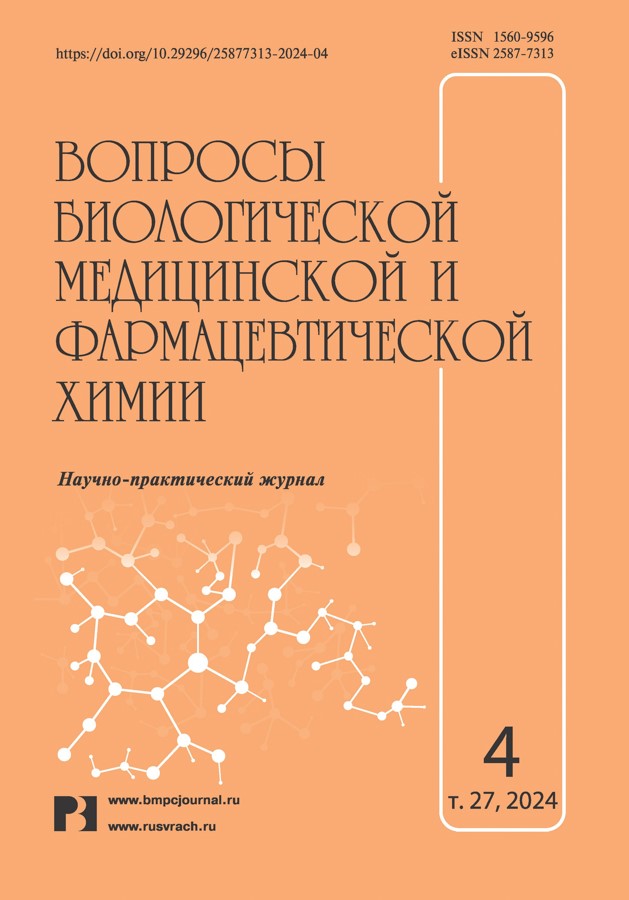New antimicrobial agents in the dihydroxanthone series: establishment of structure-activity relationships and standardization
- 作者: Frolova V.V.1, Krishtanova N.A.1, Chernov N.M.1, Gurina S.V.1, Yakovlev I.P.1
-
隶属关系:
- Saint Petersburg State Chemical and Pharmaceutical University
- 期: 卷 27, 编号 4 (2024)
- 页面: 29-35
- 栏目: Pharmaceutical chemistry
- URL: https://journals.eco-vector.com/1560-9596/article/view/631163
- DOI: https://doi.org/10.29296/25877313-2024-04-04
- ID: 631163
如何引用文章
详细
Introduction. Irrational use of antimicrobial drugs, chemical and biological agents leads to the emergence and spread of resistance in microorganisms. Therefore, there is an increasing need for the search and development of new antimicrobial compounds. Dihydroxanthone derivatives, which have a wide spectrum of action, are one of the promising groups of antimicrobial substances.
New derivatives of 4,4a-dihydroxanthone were obtained at the St. Petersburg State Chemical and Pharmaceutical University (SPCFU) at the Department of Organic Chemistry. Synthetic 4,4a-dihydroxanthones are structurally similar to antimicrobial xanthones of natural origin – fomalevones A and C. Therefore, 4,4a-dihydroxanthones are promising compounds for the creation of new antimicrobial substances.
Purpose of the study. To establish the relationship between the chemical structure of the synthesized dihydroxanthones and their antimicrobial activity and to standardize the active compound.
Materials and methods. 20 new derivatives of 4,4a-dihydroxanthone were synthesized. The structure and identity of the compounds was established using physical and chemical methods of analysis. The antimicrobial activity of these derivatives was studied by double serial dilution method. Quality standards for the most promising compound 5-bromo-7-chloro-4,4-dimethyl-9-oxo-4,4a-dihydroxanthone (a17) were developed.
Results. In preliminary studies, we found that 4,4a-dihydroxanthones synthesized in SPCFU have a pronounced effect against gram-positive bacteria. It was found, that the antibacterial activity of 4,4a-dihydroxanthone derivatives depended on their structure. The presence of substituents with acceptor properties led to an increase in activity, while donor substituents reduced the antimicrobial effect of the compounds. 5-Bromo-7-chloro-4,4-dimethyl-9-oxo-4,4a-dihydroxanthone (a17) turned out to be the most active compound, and we carried out its standardization for some indicators.
Conclusions. During the study of the antimicrobial activity of the synthesized dihydroxanthones, it was found that they are active against gram-positive bacteria. The antibacterial activity of 4,4a-dihydroxanthone derivatives depends on their structure. Among them, the most active compound was identified – leader a17, which has a pronounced antistaphylococcal effect. Its standardization has been carried out for some indicators.
全文:
作者简介
V. Frolova
Saint Petersburg State Chemical and Pharmaceutical University
编辑信件的主要联系方式.
Email: zhilyaeva.valeriya@pharminnotech.com
Assistant, Department of Pharmaceutical Chemistry
俄罗斯联邦, Saint PetersburgN. Krishtanova
Saint Petersburg State Chemical and Pharmaceutical University
Email: zhilyaeva.valeriya@pharminnotech.com
Ph.D. (Pharm.)
俄罗斯联邦, Saint PetersburgN. Chernov
Saint Petersburg State Chemical and Pharmaceutical University
Email: zhilyaeva.valeriya@pharminnotech.com
Ph.D. (Chem.)
俄罗斯联邦, Saint PetersburgS. Gurina
Saint Petersburg State Chemical and Pharmaceutical University
Email: zhilyaeva.valeriya@pharminnotech.com
Ph.D. (Biol.)
俄罗斯联邦, Saint PetersburgI. Yakovlev
Saint Petersburg State Chemical and Pharmaceutical University
Email: zhilyaeva.valeriya@pharminnotech.com
Dr.Sc. (Chem.)
俄罗斯联邦, Saint Petersburg参考
- Strategija preduprezhdenija rasprostranenija antimikrobnoj rezistentnosti v Rossijskoj Federacii na period do 2030 goda.
- Vsemirnaja organizacija zdravoohranenija. Rezhim dostupa: http://www.who.int/ru.
- Eltamany E.E., Abdelmohsen U.R., Ibrahim A.K., et al. New antibacterial xanthone from the marine sponge-derived Micrococcus sp. EG45. Bioorganic and Medicinal Chemistry Letters. 2014; 24(21): 4939–4942; https://doi.org/10.1016/j.bmcl.2014.09.040.
- Pinto M.M.M., Sousa M.E., Nascimento M.S.J. Xanthone Derivatives: New Insights in Biological Activities. Current Medicinal Chemistry. 2005; 12(21): 2517–2538; https://doi.org/10.2174/092986705774370691.
- Chernov N.M., Shutov R.V., Jakovlev I.P. Digidroksantony: himija i biologicheskaja aktivnost': monogr. 2019; 154 s.
- Frolova V.V., Gurina S.V., Chernov N.M., Jakovlev I.P. Sravnitel'naja ocenka protivomikrobnoj aktivnosti soedinenij rjada ksantonov. Bakteriologija. 2019; 4(2): 65–66.
- Shim S.H., Baltrusaitis J., Gloer J.B., Wicklow D.T. Phomalevones A−C: Dimeric and Pseudodimeric Polyketides from a Fungicolous Hawaiian Isolate of Phoma sp. (Cucurbitariaceae). Joutnal of Natural Products. 2011; 74(3): 395–401. doi: 10.1021/np100791b.
- Frolova V.V., Gurina S.V., Chernov N.M., Jakovlev I.P. 4,4a-digidroksantony kak perspektivnye soedinenija dlja sozdanija novyh antimikrobnyh preparatov. Antibiotiki i himioterapija. 2019; 64(11-12): 3–7.
- Chernov N.M., Shutov R.V., Sharoyko V.V., et al. Synthetic Route to 4,4a- and 3,4-Dihydroxanthones through [4+2] Cycloaddition and Base-Assisted Sigmatropic Rearrangement. European Journal of Organic Chemistry. 2017; 19: 2836–2841; https://doi.org/10.1002/ejoc.201700310.
- Gosudarstvennoj Farmakopeej RF XV izd. Tom [Jelektronnoe izdanie]. Rezhim dostupa: https://pharmacopoeia.regmed.ru/pharmacopoeia/izdanie-15/.
- Rukovodstvo po provedeniju doklinicheskih issledovanij lekarstvennyh sredstv. Chast' pervaja. M.: Grif i K. 2012. 944 s.
- Frolova V.V., Chernov N.M., Ivkin D.Ju., i dr. Opredelenie vozmozhnoj misheni dejstvija 4,4a-digidroksantonov v bakterial'nyh kletkah. Zhurnal mikrobiologii, jepidemiologii i immunobiologii. 2021; 98(5): 558–566; https://doi.org/10.36233/0372-9311-118.
- Frolova V.V., Gurina S.V., Chernov N.M., Jakovlev I.P. Vzaimosvjaz' mezhdu stroeniem novyh proizvodnyh digidroksantona i ih protivomikrobnoj aktivnost'ju. Materialy Mezhdunarodnoj konferencii, posvjashhennoj 60-letiju farmacevticheskogo fakul'teta uchrezhdenija obrazovanija «Vitebskij gosudarstvennyj ordena Druzhby narodov medicinskij universitet» (Vitebsk, 31 okt. 2019 g.). Pod red. A. T. Shhastnogo. Vitebsk: VGMU. 2019: 30–33.
补充文件









